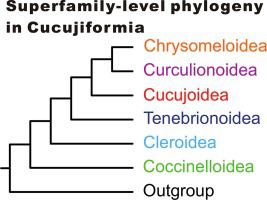Molecular Phylogenetics and Evolution ( IF 3.6 ) Pub Date : 2022-12-17 , DOI: 10.1016/j.ympev.2022.107679 Ming-Long Yuan 1 , Wen-Ting Chen 1 , Qi-Lin Zhang 2 , Min Li 1 , Li Zhang 1 , Pei-An Tang 3

|
Cucujiformia, the largest taxon in the order Coleoptera, exhibits extraordinary morphological, ecological, and behavioral diversity. This infraorder is currently divided into seven superfamilies, but considerably incongruent relationships among superfamilies have been reported by recent phylogenomic studies. Here, we combined the 21 newly sequenced transcriptomes representing six superfamilies with nine previously published cucujiform genomes/transcriptomes to elucidate the phylogeny and evolution of Cucujiformia. The monophyly of each of five superfamilies were consistently supported by all phylogenetic analyses based on the twelve datasets (matrix occupancy, amino acid and nucleotide data) and the two analytical methods (maximum likelihood method and Bayesian inference). Both the amino acid datasets and the RY recoded nucleotide datasets recovered the monophyly of Cucujoidea. Topology test results statistically supported the following robust superfamily-level phylogeny in Cucujiformia: (Coccinelloidea, (Cleroidea, (Tenebrionoidea, (Cucujoidea, (Chrysomeloidea, Curculionoidea))))). Our divergence time analyses recovered a Permian origin of Cucujiformia and a Jurassic–Cretaceous origin of most superfamilies. The diversification of phytophagous beetles that occurred in the Cretaceous can be attributed to its co-evolution with angiosperms, supporting the hypothesis of a Cretaceous Terrestrial Revolution.
中文翻译:

转录组学数据恢复了 Cucujiformia(鞘翅目、多食动物)的一个新的超家族级系统发育
Cucujiformia 是鞘翅目中最大的分类单元,表现出非凡的形态、生态和行为多样性。该下目目前分为七个超科,但最近的系统发育学研究报告了超科之间相当不一致的关系。在这里,我们将代表六个超科的 21 个新测序的转录组与之前发表的九个葫芦形基因组/转录组相结合,以阐明葫芦形目的系统发育和进化。基于十二个数据集(矩阵占有率、氨基酸和核苷酸数据)和两种分析方法(最大似然法和贝叶斯推理)的所有系统发育分析始终支持五个超科中每一个的单系。氨基酸数据集和 RY 重新编码的核苷酸数据集都恢复了 Cucujoidea 的单系性。拓扑测试结果统计支持 Cucujiformia 中以下稳健的超科级系统发育:(Coccinelloidea,(Cleroidea,(Tenebrionoidea,(Cucujoidea,(Chrysomeloidea,Curculionoidea)))))。我们的分歧时间分析恢复了 Cucujiformia 的二叠纪起源和大多数超科的侏罗纪-白垩纪起源。白垩纪植食性甲虫的多样化可以归因于它与被子植物的共同进化,支持白垩纪地球革命的假说。象牙科))))))。我们的分歧时间分析恢复了 Cucujiformia 的二叠纪起源和大多数超科的侏罗纪-白垩纪起源。白垩纪植食性甲虫的多样化可以归因于它与被子植物的共同进化,支持白垩纪地球革命的假说。象牙科))))))。我们的分歧时间分析恢复了 Cucujiformia 的二叠纪起源和大多数超科的侏罗纪-白垩纪起源。白垩纪植食性甲虫的多样化可以归因于它与被子植物的共同进化,支持白垩纪地球革命的假说。





















































 京公网安备 11010802027423号
京公网安备 11010802027423号